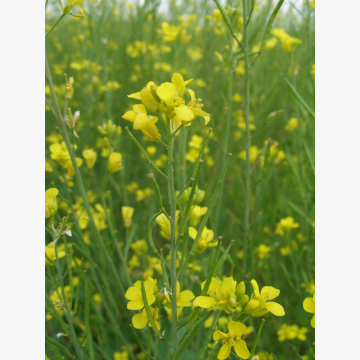- Home
- Seeds
- Oil / seasoning plants, etc.
- Brown mustard
- Brown mustard CAPELINE
FOR CONSULTATIONS APPLY TO:
Commercial director
Lina Smalskienė
tel. +370 618 02 551
e-mail linak@agrolitpa.lt
Sales manager
Tautvydas Kliučininkas
tel. +370 681 35 093
e-mail tautvydask@agrolitpa.lt
Sales manager
Eglė Petkevičienė
tel. +370 626 95 458
e-mail eglep@agrolitpa.lt
Sales manager
Kotryna Nakrošytė
tel.: +370 601 39 282
e-mail kotryna@agrolitpa.lt
Brown mustard CAPELINE
A medium early brown mustard for soil biofumigation
- Fast growing
- High biomass yield
- Very resistant to diseases
- C/N ratio – 20,4
- Recommended for soil improvement ant biofumigation
- Sensitive to H. schachtii
- Growth rate – 8.5 points
- Coverage power at 200 °C – 27 %
- Coverage power at 2300 °C – 63 %
- Plant height during flowering – 103 cm
- Resistance to various diseases – 9.0 points
- Biomass yield in 2018 – 2.3 t/ha
- Amount of accumulated nitrogen – 46 kg/ha
- C/N ratio – 22.1
- Biomass yield in 2019 – 3.1 t/ha
- Amount of accumulated nitrogen – 65 kg/ha
- C/N ratio – 20.4
- Biomass yield – 2.7 t/ha on average
- Accumulated nitrogen – on average 55 kg/ha
- Attack index of nematode H. schachtii– 95.3
- Resistance index of nematode H. schachtii – < 0
- Resistance class of H. schachtii – S (susceptible)
*according to: CTPS/GEVES, https://cat.geves.fr/CAT_WEB/Data/PLA_Plantes_de_services_2019.pdf
Recommended use for the best biofumigation effect:
- The pre-crop is harvested
- The soil is prepared for sowing
- Sowing brown mustard (as catch crop)
- Cultivated until flowering
- Biofumigation goes best by incorporating chopped flowering plants into moist soil
- The most optimal term is the beginning of flowering + 10 days; the latest – the beginning of flowering + 20 days
- After mustard incorporation, at least 10-15 days must pass before sowing the next crop
The varietal parameters may differ from those indicated here when the testing circumstances differ from quondam
Recommended sowing rate: 100-120 plants/m² or 10-12 kg/ha
Recommended sowing rate when growing for green manure: 12-15 kg/ha
Keravos sreet. 17, Kerava,
LT-38 131 Panevėžys district, LITHUANIA
Enterprise's code 168598128
VAT code LT685981219
Tel. +370 615 11 315
E. mail info@agrolitpa.lt




.JPG)


